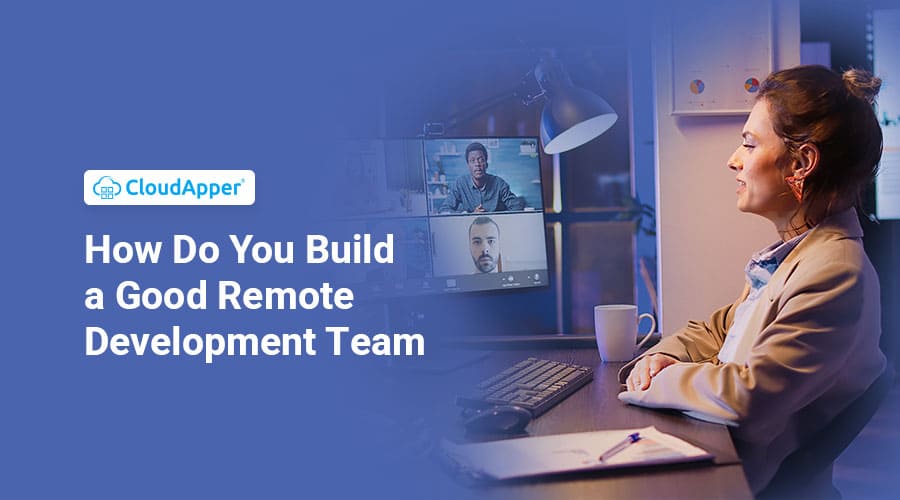Break free from the challenges of building good remote development team. With CloudApper AI, automate software development, ensure intellectual property protection, and embrace a culture of collaboration. Experience the power of seamless human-computer interaction and propel your business to digital success.
Table of Contents
Building a solid and effective software development team is difficult in and of itself, and the complexity rises when dealing with remote teams. Building a good remote development team, on the other hand, is not only achievable but can also provide multiple benefits to your firm with the correct strategy and practical management abilities. In this post, we will look at tried-and-true tactics and best practices for putting together a solid remote development team, as well as address important issues and provide practical insights to help you navigate the process efficiently.
Why Do Companies Create a Remote Development Team?
For a variety of reasons, businesses are increasingly forming remote development teams. It gives companies access to a worldwide talent pool, allowing them to overcome the lack of competent software engineers. Remote teams provide firms with flexibility and scalability, allowing them to swiftly adjust to changing demands. However, issues like human dependency, poor coding talents, and information retention persist.
CloudApper AI is an appealing alternative. It automates coding chores, reduces repeated rewriting, and keeps critical product knowledge via its AI-powered platform.
CloudApper AI accelerates the development process, stimulates cooperation, and assures consistent and high-quality code by decreasing reliance on individual developers. Companies may use CloudApper AI to create a pleasant team atmosphere by concentrating on soft skills while benefiting from an innovative and dependable software development solution. Embrace CloudApper AI to change your development process and unleash your team’s full potential.
Finding the Right Soft Skills Talent
Hiring a remote development team involves more than just technical know-how. Look for applicants that have strong communication skills, work well in groups, and share your company’s values. You may maintain a peaceful and collaborative work atmosphere by prioritizing soft skills during the interview process.
While technical competence is required, assembling a remote development team necessitates more than simply technical abilities. Overcoming issues such as human dependency, poor coding talents, code rewriting, and the danger of losing vital information are crucial. CloudApper AI provides a convincing answer to these difficulties while also streamlining the development process.
You may lessen your reliance on individual developers and assure a more efficient and streamlined approach by utilizing our AI-powered platform. CloudApper AI automates the software development process, eliminating the need for recurrent code rewriting and preserving critical product knowledge. You may create a harmonic and collaborative team atmosphere with CloudApper AI, concentrating on your core business tasks while benefiting from an innovative and dependable software development solution.
Balancing Freedom and Responsibility
Adopt a culture of freedom and responsibility within your remote staff, inspired by successful firms such as Netflix. Encourage trust and openness by giving team members liberty in their work while keeping them responsible for their promises. This method encourages innovation and enables people to give their all to the project.
While adopting a culture of independence and responsibility is crucial for remote teams, it is also critical to recognize the possible loss of control. It can be difficult to establish accountability and measure success without the necessary tools and mechanisms in place. This might result in delays, misunderstandings, and lower production.
CloudApper, on the other hand, is a superior solution. CloudApper’s AI-powered platform enables you to keep control and visibility over your software development project through a complete communication process. From software development to deployment, a dedicated CloudApper solution professional keeps you updated on the project’s progress and supports any customisation requirements. You can achieve the proper mix between liberty and responsibility with CloudApper, supporting a creative process while ensuring project success.
Aligning Business Needs and Goals
While technical expertise is required, it is also critical that your remote development team knows your business goals. During the hiring process, emphasize the importance of offering solutions that correspond with business goals, and evaluate applicants based on their business-oriented approach.
While aligning company needs and goals with a remote development team is critical, cultural differences and knowledge gaps might make it difficult to construct a workforce that can genuinely adapt to your unique organizational requirements. CloudApper, on the other hand, provides a fully adaptable platform that may customize your program to your exact demands. CloudApper gives you the freedom to customize the platform to meet your specific business goals. CloudApper gives the tools and capabilities to fulfill your particular organizational needs, whether it’s adapting workflows, connecting with current systems, or incorporating customized features.
Organizing the Development Process
Establishing defined working practices is critical for a remote development team’s productivity and efficiency. Give a thorough summary of the project, including its origins, aims, and the domain in which the final product will function. This transparency allows the team to obtain a thorough knowledge and provide realistic estimations.
Choosing Effective Communication Tools
A remote development team’s lifeblood is effective communication. Slack for daily operations, Jira for task management, and Zoom or Google Meet for video conferencing are examples of acceptable communication and project management platforms that promote seamless cooperation. These technologies facilitate communication and aid in bridging physical distances between team members.
Documenting Project Requirements
Thorough documentation is required for remote development teams to collaborate effectively. Collaborate with the team to create a list of all functional and non-functional specs, as well as clear standards and expectations. In order to establish a sense of ownership and alignment with the project goals, involve the team in the process of creating requirements.
Establishing Regular Meetings
Keeping remote teams engaged and aligned requires regular contact. Create a meeting schedule that includes backlog grooming sessions, planning meetings, daily check-ins, sprint demonstrations, and retrospectives. These frequent meetings enhance openness, allow for progress monitoring, and foster team collaboration.
Building Personal Connections
Organize informal online meetings and individual check-ins to encourage personal connections among team members. These encounters promote camaraderie, trust, and understanding, which improves cooperation and teamwork. Set aside time for both professional and casual chats to improve team ties.
Clearly Define tasks and Responsibilities
Define each team member’s tasks and responsibilities to guarantee clarity and minimize duplication of efforts. Include software developers, QA engineers, project managers, UX/UI designers, product owners, and business analysts depending on the demands of the project. Delineating responsibilities clearly aids in the development process and promotes appropriate work allocation.
Adopting Agile approaches
Use agile approaches such as Scrum to improve efficiency and adaptability in remote software development. Iterative development, frequent feedback loops, and continual improvement are all emphasized. Agile approaches encourage cooperation, improve communication, and allow teams to react quickly to changing project needs.
Do You Really Want to Build a Remote Development Team?
When a company considers forming a remote team of developers, it must be aware of the potential pitfalls. These include relying on individual developers, dealing with developers who lack coding abilities and must continuously rewrite code, and the possibility of developers departing with important product knowledge. CloudApper, on the other hand, provides a solution that overcomes these problems. CloudApper eliminates the need to keep a staff of developers by handling DevOps, which includes maintenance, software updates, technical support, system upgrades, hosting administration, and cyber security monitoring. Furthermore, our AI-powered systems can analyze enormous datasets, collecting useful information that can be used to improve software and improve user experience. Businesses may gain more control over their projects, remove the risks associated with outsourcing, automate the software development process, tailor the platform to their unique needs, and benefit from cost-effective solutions by utilizing CloudApper.
CloudApper makes software development more accessible and intuitive through seamless human-computer interaction, assuring a successful and efficient development experience.
Final Words
Building a successful remote development team necessitates a deliberate strategy that blends technical and soft talents, excellent communication, and strong project management. You can construct a remote team that flourishes and provides excellent outcomes by concentrating on selecting employees who connect with your company’s values, setting clear working processes, promoting communication, and embracing agile approaches. Remember that trust, openness, and constant improvement are critical to the success of a remote team.
Finally, given the possible difficulties and hazards, assembling a team of remote engineers might be a difficult task. Organizations, however, may overcome these hurdles and reap a variety of benefits by implementing CloudApper AI. Businesses may assure a more streamlined and effective software development process by eliminating reliance on individual developers. CloudApper AI provides a highly adaptable platform that can be adjusted to unique organizational demands, allowing firms to connect their software solutions with their company goals. CloudApper AI enables enterprises to prosper in the digital ecosystem through automated tasks, data analysis, seamless human-computer interaction, and full support services. Businesses may minimize the hassles and risks involved with developing and maintaining a remote development team by adopting CloudApper AI, while also reaping the benefits of an innovative and dependable software development solution. Experience the revolutionary potential of CloudApper AI and catapult your business to digital success.
What is CloudApper AI Platform?
CloudApper AI is an advanced platform that enables organizations to integrate AI into their existing enterprise systems effortlessly, without the need for technical expertise, costly development, or upgrading the underlying infrastructure. By transforming legacy systems into AI-capable solutions, CloudApper allows companies to harness the power of Generative AI quickly and efficiently. This approach has been successfully implemented with leading systems like UKG, Workday, Oracle, Paradox, Amazon AWS Bedrock and can be applied across various industries, helping businesses enhance productivity, automate processes, and gain deeper insights without the usual complexities. With CloudApper AI, you can start experiencing the transformative benefits of AI today. Learn More

Brochure
CloudApper hrPad
Empower Frontline Employees with an AI-Powered Tablet/iPad Solution
Download Brochure
CloudApper AI Solutions for HR



- Works with








- and more.
Similar Posts

How to Hire a Mobile Application Developer For Enterprise?

How Do I Hire a Freelance Web App Developer?



